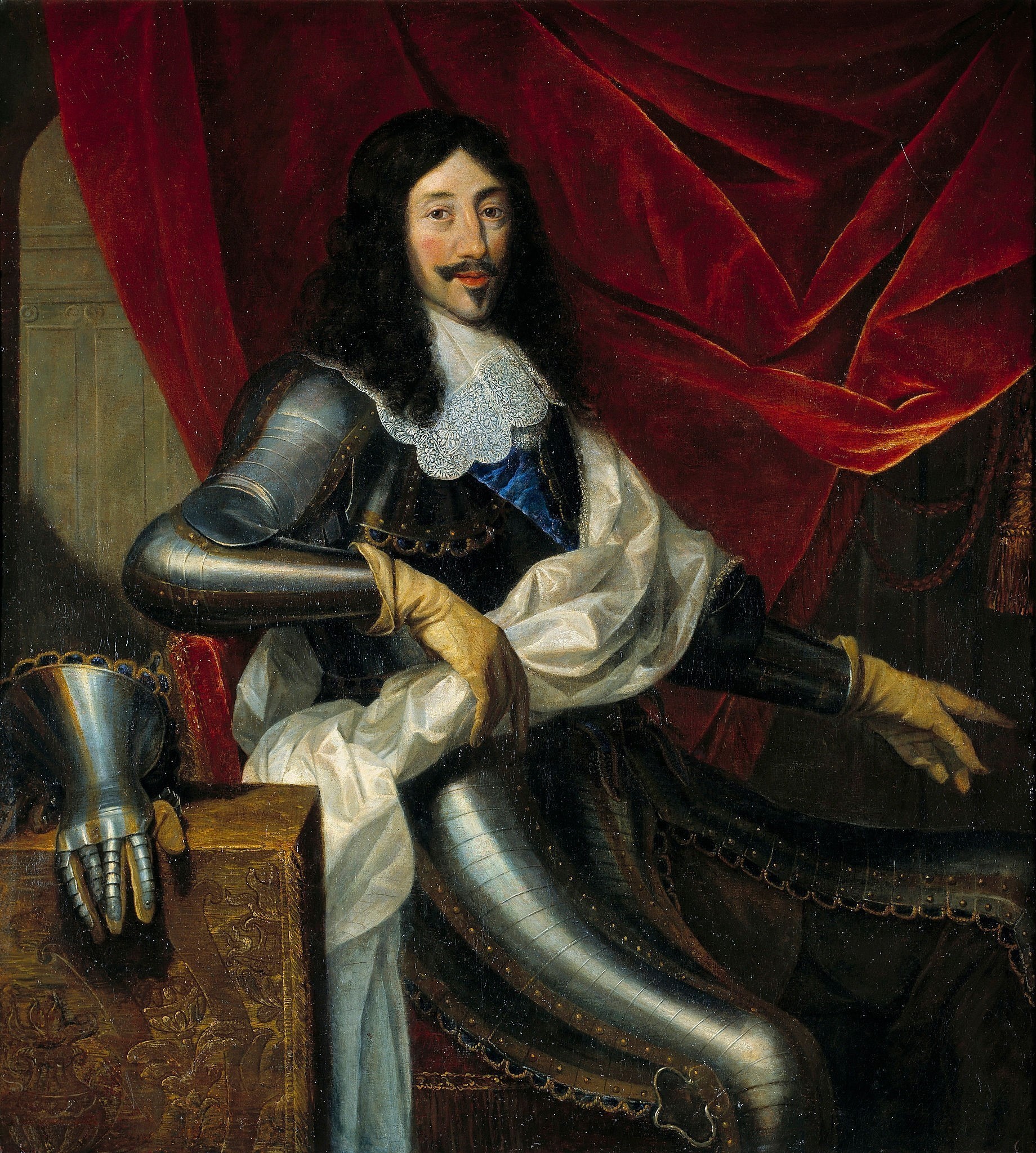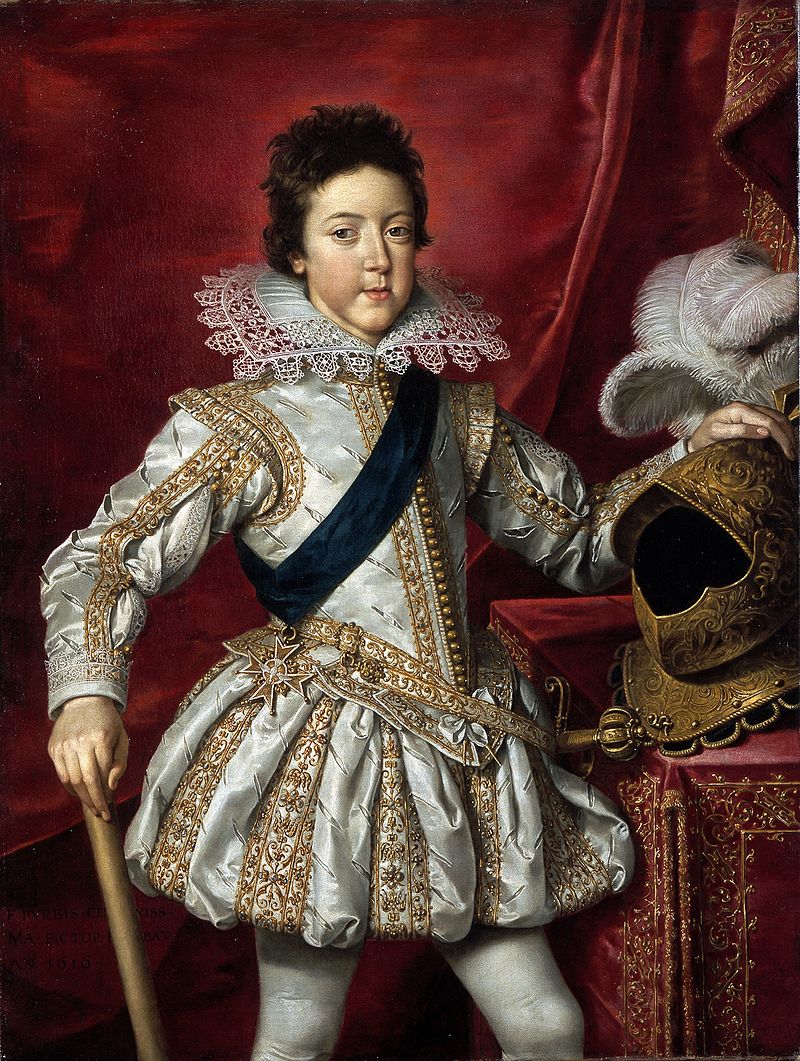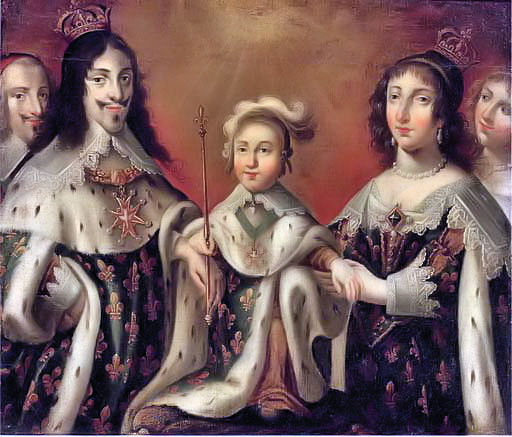by Scott Mehl © Unofficial Royalty 2016

source: Wikipedia
King Louis XIII of France
King Louis XIII of France was born September 27, 1601, at the Château de Fontainebleau in Fontainebleau, Seine-et-Marne, France. He was the eldest son of King Henri IV of France and Marie de’ Medici, and had five younger siblings:
- Elisabeth (1602 – 1644) – married King Felipe IV of Spain, had issue
- Christine Marie (1606 – 1663) – married Vittorio Amedeo I, Duke of Savoy, had issue
- Nicolas Henri, Duke of Orléans (1607 – 1611) – died in childhood
- Gaston, Duke of Orléans (1608 – 1660) – married (1) Marie de Bourbon, Duchess de Montpensier, had issue; (2) Marguerite of Lorraine, had issue
- Henrietta Maria (1609 – 1669) – married King Charles I of England, had issue
At just two months old, Louis was brought to the Château de Saint-Germain-en-Laye, where he was raised along with his father’s illegitimate children, and later his own siblings. He was nearly five years old when his christening took place at Fontainebleau in September 1606. His godparents were Pope Paul V, and his maternal aunt, Eleonora de’ Medici, Duchess of Mantua.
From a young age, Louis showed a great interest in music and learned to play the lute at just three years old. This love of music continued for his entire life, and in 1635 he wrote The Ballet de la Merlaison which was first performed that year at the Château de Chantilly. Louis is credited with writing the story, composing the music and lyrics, and choreographing the dancing. He also danced in several performances of the show.

King Louis XIII, c1613. source: Wikipedia
Louis also developed an early love of horses and the military. Once his education began, he did not show much interest in languages, math, or science, but excelled in history as well as the arts. Growing up, he was much closer to his father than his mother, despite the fact that the King would often mistreat him. Sadly, Louis was only eight years old when his father King Henri IV was assassinated on May 14, 1610, and he became King Louis XIII of France. Due to his youth, his mother Marie de’ Medici was appointed Regent, to serve until he became of age. Despite reaching his majority in 1614, his mother continued to exert her influence as Regent, deeming her son “too weak in body and spirit” to assume his rightful position.
It would be several years before Louis asserted his authority. In April 1617, he organized a coup d’état, ousting his mother’s primary minister Concino Concini and sending his mother into exile. He replaced Concini with his favorite advisor, Charles d’Albert, Duke of Luynes. One of the first challenges in his reign was the Thirty Years’ War which began in 1618, in which there was much disagreement on which side the French should support. There was also growing disagreement with Luynes and his actions. These all led to a rebellion against the King, led by his own mother who had escaped from exile. Through the influence of the Duke of Richelieu (later Cardinal), Louis and his mother were reconciled, and within a few years, he permitted her to return to the French court. By 1624, Louis was now ruled by council and Cardinal Richelieu was taking a more prominent role in the King’s reign.

“The Marriage of Louis XIII, King of France and of Navarre, and Anna of Austria” by Jean Chalette. source: Wikipedia
In 1612, at just eleven years old, Louis became betrothed to Anna of Austria, in keeping with the tradition of inter-marriages between the French and Spanish monarchies. She was the daughter of King Felipe III of Spain and Margaret of Austria. The couple was married by proxy on October 18, 1615, in Burgos, Spain. The same day, Louis’s sister Elisabeth was married to Anna’s brother, the future King Felipe IV of Spain. Following Anna’s arrival in France, the couple was married in a religious ceremony at the Bordeaux Cathedral in France on November 24, 1615. After four stillborn children, and 23 years after their marriage, the couple had two sons:
- King Louis XIV of France (1638 – 1715) – married (1) Maria Theresa of Spain, had issue (2) Françoise d’Aubigné, Marquise de Maintenon, no issue
- Philippe I, Duke of Orléans (1640 – 1701) – married (1) Henrietta of England, had issue; (2) Elisabeth Charlotte of the Palatinate, had issue

The hunting lodge at Versailles, c1630-1640. source: Wikipedia
Although best associated with later generations of French monarchs, the Palace of Versailles has its origins with Louis XIII. Having gone on several hunting trips in the area, King Louis XIII ordered the construction of a hunting lodge in 1624. Several years later, he acquired the surrounding land and began to enlarge the building. It was under his son’s reign that the small hunting lodge was transformed into a grand palace, and became the seat of the French monarchy.

King Louis XIII and Queen Anne with their eldest son, the future King Louis XIV. Cardinal Richelieu is pictured behind the King. source: Wikipedia
After several weeks of intense illness, King Louis XIII died in Paris on May 14, 1643. Ironically, it was 33 years earlier on the same day that his own father had died. Just like his father, Louis left behind a very young son – not yet five years old – to succeed him on the French throne. He was interred at the Basilica of St. Denis near Paris, France with very little pomp or ceremony, per his own wishes that the French people not be subjected to any excessive or unnecessary expense due to his death. Knowing his death was near, the King had revised his will, limiting the powers of his wife who would go on to serve as Regent for their young son.
This article is the intellectual property of Unofficial Royalty and is NOT TO BE COPIED, EDITED, OR POSTED IN ANY FORM ON ANOTHER WEBSITE under any circumstances. It is permissible to use a link that directs to Unofficial Royalty.
France Resources at Unofficial Royalty
